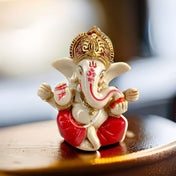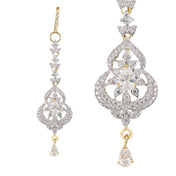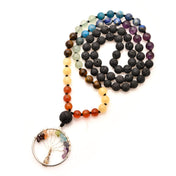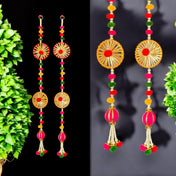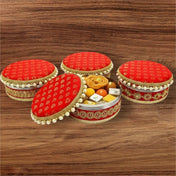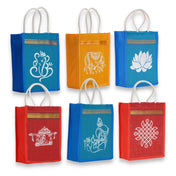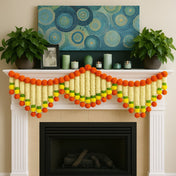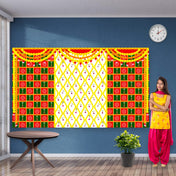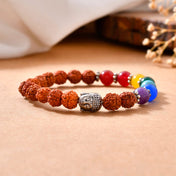Introduction: Garba and Dandiya
Garba: The History and Meaning of Navratri's Joyful Dance invites you to explore one of Hinduism’s most vibrant cultural celebrations—Navratri. This nine-night festival honors the divine feminine, celebrating Goddess Durga’s triumph over evil. Rooted deeply in spiritual devotion and community joy, Navratri remains a cornerstone of Hindu cultural identity across India and its diaspora.
At the heart of Navratri lies Garba, a traditional folk dance originating from Gujarat. Garba is more than just rhythmic movement; it is an exuberant expression of faith, fertility, and festivity. Dancers move gracefully in circular patterns around a central lamp or icon, symbolizing life's cyclical nature and the divine energy within.
This article aims to educate US audiences about Navratri dance history, unpacking Garba’s origins, symbolism, and evolving celebrations worldwide. As Navratri garners increasing popularity in North America, understanding its rich heritage becomes essential for meaningful participation.
LoveNspire stands as a trusted source for authentic ethnic products designed to enhance Navratri celebration US experiences. From traditional attire to handcrafted décor, LoveNspire offers carefully curated items that bring the spirit of Garba and Navratri alive in homes and communities across the United States. Their range includes personalized Diwali gifts and decorative items for Durga Puja, which are perfect for enhancing the festive atmosphere.
Embrace the essence of navratri garba through this journey into tradition, culture, and joyous dance.
The Origins and Historical Significance of Garba
The word Garba comes from the Sanskrit word Garbha, which means womb. This meaning shows the spiritual and symbolic importance of the dance, connecting it to ideas of creation, fertility, and the sacred feminine. The dance is not only a celebration of life but also a way to call upon the divine energy that nurtures existence.
Garba's Roots in Gujarat
Garba has its roots in Gujarat, India, where it became a lively folk dance tradition performed during the Hindu festival of Navratri. This nine-night festival honors the goddess Durga and her various forms, marking a time for spiritual renewal and community celebration. In Gujarat’s villages and towns, Garba became an essential cultural expression that brought people together in devotion and joy.

Symbolism in Garba
At its core, Garba represents fertility, life, and the feminine divine. The circular movements and rhythmic clapping imitate cycles of life—birth, growth, death, and rebirth—which are central themes in Hindu philosophy. Participants dance around a central object known as the garbha deep, a clay lantern or pot containing an earthen lamp. This vessel symbolizes the womb as a source of life and creativity. The flickering flame inside it is revered as the soul residing within the womb—the eternal spark of existence.
Spiritual Significance of Garbha Deep
The garbha deep holds profound spiritual significance during Navratri celebrations:
- Acts as a physical embodiment of Shakti, or divine feminine power.
- Serves as a focal point for prayers invoking protection and blessings.
- Symbolizes light overcoming darkness, knowledge dispelling ignorance.
Through centuries, this ritualistic use of the clay lantern along with circular group dancing has preserved Garba’s essence as more than just entertainment—it remains a sacred homage to life’s mysteries and feminine strength deeply woven into Hindu festival traditions.
Symbolism and Spiritual Meaning Behind Garba Dance
The essence of Garba symbolism is deeply intertwined with Hindu philosophical concepts, particularly the notion of cyclical time or Kāla. The dance’s circular formation is not merely an aesthetic choice but a profound reflection of the universe’s eternal cycles. Participants move rhythmically in concentric circles, embodying the continuous flow of time — a cycle without beginning or end.
1. Circular Dance Formation
The dancers’ movement around a central lamp or image symbolizes the cosmic wheel, representing the endless cycles of birth, life, death, and rebirth. This cyclical nature resonates with Hindu teachings where existence is seen as an ongoing process rather than linear progression.
2. Representation of Life Cycles
Each step and gesture in Garba mirrors stages of human existence: emergence from the womb, growth, eventual decline, and renewal. The collective motion captures this perpetual rhythm, instilling a sense of harmony between human life and cosmic order.
3. Central Role of Goddess Amba (Durga)
Worshipped during Navratri, Goddess Amba embodies the feminine divine energy — strength, protection, and nurturing power. Garba serves as a devotional expression honoring her fierce yet compassionate spirit. Through dance, devotees connect with her dynamic essence, celebrating feminine empowerment and divine motherhood.
4. Symbolism of the Vessel or Lamp
At the heart of the circle often stands a clay lantern known as garbha deep, representing both the womb and the human body as sacred vessels. This lamp symbolizes the soul or divine energy contained within us. Dancing around it acknowledges that every individual houses this inner light — a spark of universal consciousness guiding life’s journey.
This rich tapestry of symbolism makes Garba more than just a festive dance; it is a moving meditation on existence, divinity, and renewal woven seamlessly into joyful celebration.
Cultural and Social Importance of Garba in Indian Traditions
Garba holds a profound cultural role beyond its vibrant dance steps and festive beats. Traditionally, this dance marks significant milestones in the lives of young girls, particularly celebrating first menstruation—a pivotal rite of passage symbolizing the transition into womanhood. Participating in Garba during Navratri becomes a joyful acknowledgment of this new chapter, imbuing the event with spiritual and communal significance.
Celebrating Womanhood
Wedding preparations also intertwine with Garba’s cultural fabric. The dance often heralds the impending marriage of girls within the community, serving as a collective blessing for fertility, prosperity, and happiness. As an expression of hope and reverence for feminine energy, Garba embodies the celebration of womanhood, honorably linking generations through shared customs.
Strengthening Social Bonds
The dance transcends individual milestones to reinforce social cohesion. During Navratri, Garba becomes a dynamic platform where communities gather, exchange stories, and strengthen bonds. The circular formation mirrors not only cosmic cycles but also the close-knit social circles that come alive through synchronized movements and rhythmic claps. In this way, Garba nurtures a sense of belonging—a communal heartbeat pulsing with shared joy and cultural pride.
Connecting Diaspora Communities
Garba’s role in Navratri rituals resonates strongly with diaspora communities in the US, who embrace it as a vital thread connecting them to ancestral roots while fostering new friendships and cultural appreciation across generations. Its ability to unite people—women and men alike—in celebration ensures that Navratri remains a vibrant festival full of life, tradition, and heartfelt connection.
“Garba is more than dance; it is an enduring tribute to life’s rhythms woven into the fabric of Indian cultural heritage.”
This deep-rooted social function enriches Navratri’s spirit, making every step taken in the circle a step toward honoring both personal milestones and collective identity. To enhance your Navratri celebrations, consider incorporating traditional elements such as a Happy Navratri banner, which can serve as a beautiful backdrop for your festive decor.

Traditional Attire and Music Associated with Garba
The Garba dress code is a vivid celebration of color, craftsmanship, and cultural identity, showcasing the rich textile heritage of Gujarat. Women traditionally wear the chaniya choli, a three-piece ensemble consisting of:
- A flared, embroidered skirt (chaniya) adorned with mirror work and vibrant thread designs
- A fitted blouse (choli) often matching or contrasting the skirt in dazzling colors
- A dupatta or scarf draped elegantly to complement the outfit
Jewelry plays an essential role in enhancing the overall appearance. Ornate pieces such as bangles, necklaces, earrings, nose rings, and bajuband (armlets) add sparkle and tradition to the Garba attire. The intricate embroidery and embellishments reflect meticulous handwork passed down through generations.
Men don the traditional kediyu — a pleated, short kurta paired with dhoti-style pants or churidars. The kediyu is often decorated with bold patterns and mirror work that resonate with the festive energy of Garba nights. Turbans (pagdis) are sometimes worn to complete the look, adding regal flair.
Rhythm stands at the heart of Garba celebrations. The dhol music propels dancers into joyful motion with its pulsating beats. The dhol, a large barrel-shaped drum played with sticks, produces deep bass tones that anchor the tempo. The dholak, smaller and hand-played, offers complementary rhythms that create complex layers of sound.
Other instruments like manjira (small cymbals), tabla, and harmonium occasionally enrich the musical ensemble, making each performance vibrant and immersive.
The visual spectacle of swirling skirts paired with synchronized footwork against this backdrop of energetic drumming captivates audiences worldwide. In chaniya choli USA festivals, these elements combine to evoke a festive ambiance reminiscent of Gujarat’s Navratri nights while celebrating Indian heritage abroad.
The traditional attire and music together transform every Garba event into a multisensory experience — colorful fabrics catching light mid-spin, rhythmic beats inspiring movement, and a communal spirit uniting participants through shared cultural expression.
Evolution of Garba: From Tradition to Global Celebrations
Garba dance has undergone a vibrant transformation, blending traditional roots with contemporary expressions that invigorate its timeless appeal. A notable development is the fusion of traditional Garba with Dandiya Raas, a stick dance form originating from Gujarat. This combination elevates the festive energy and broadens participation by incorporating rhythmic stick movements alongside the graceful circular steps of Garba. The synergy between these two dances creates a dynamic experience that captivates dancers and audiences alike.
The growth of modern Garba dance reflects the cultural vitality of Indian communities beyond India’s borders. In North America and the United Kingdom, Indian diaspora populations have enthusiastically embraced Garba as a way to maintain connections with their heritage while sharing it with broader multicultural audiences. This enthusiasm has sparked the rise of large-scale, public Navratri celebrations characterized by authentic cultural expressions and spirited performances.
Several US cities have become hubs for these grand Navratri festivities:
- New York City hosts extensive outdoor events featuring live dhol players, professional dancers, and vibrant stages adorned with traditional motifs.
- San Francisco Bay Area organizes community-driven Garba nights combining music, dance competitions, and ethnic food fairs.
- Chicago sees massive gatherings at convention centers where thousands participate in continuous Garba and Dandiya rounds over multiple evenings.
These celebrations foster not only entertainment but also deep social bonding within diaspora communities. They serve as vital platforms for cultural education and pride, showcasing exquisite ethnic attire, traditional music ensembles, and ritualistic elements integral to Navratri.
The global spread of Garba underscores its adaptability and enduring relevance. It bridges generations by honoring heritage while inviting innovation—qualities that resonate strongly with the evolving identities of Indian-origin populations worldwide.
UNESCO Recognition and Cultural Preservation
The inclusion of Garba in the UNESCO Intangible Cultural Heritage of Humanity list in 2023 marked a milestone in the global appreciation of this vibrant Navratri dance. This recognition highlights Garba not only as a festive tradition but as a vital cultural expression that embodies centuries of history, spirituality, and community bonding.
Significance of UNESCO intangible heritage status:
- Validates the cultural importance of Garba on an international platform
- Encourages safeguarding measures to maintain the authenticity and continuity of the dance
- Elevates awareness about Garba beyond Indian borders, fostering cross-cultural understanding
Preserving Garba transcends mere performance; it nurtures the living heritage that connects generations. As communities worldwide celebrate Navratri, the dance acts as a conduit for transmitting values tied to feminine divinity, cyclical time, and social unity. The cultural preservation Navratri dance efforts involve both oral traditions—songs and stories—and material culture such as costumes and instruments.
Community engagement plays a pivotal role in sustaining Garba’s vibrancy. Festivals serve as dynamic spaces where cultural identity is expressed and reinforced through collective participation. Local groups, diaspora organizations, and cultural institutions collaborate to host events that honor traditional choreography while embracing contemporary interpretations. This interaction keeps the practice relevant and accessible to younger generations unfamiliar with its origins.
“Garba’s recognition by UNESCO is not just about safeguarding a dance; it is about preserving a worldview embedded in rhythm, movement, and devotion,” emphasizes cultural scholars studying Indian folk traditions.
The global celebration of Garba benefits from these preservation initiatives by ensuring that the joy, symbolism, and spiritual significance continue to inspire communities everywhere. Through active participation and conscious efforts to honor its roots, Garba remains an enduring emblem of cultural pride during Navratri festivities worldwide.
How to Celebrate Navratri with Authenticity in the US – Tips from LoveNspire
Creating an immersive and genuine Navratri celebration experience in the USA involves thoughtful incorporation of traditional elements that resonate deeply with the festival's spirit. LoveNspire offers a curated selection of authentic ethnic decor and accessories designed to enrich festive gatherings, whether at home or community events.
Key ideas for an authentic Navratri celebration:
1. Traditional Decorations
Use vibrant flower garlands and intricate torans available at LoveNspire to adorn doorways, puja spaces, and event venues. These timeless decorations not only brighten the environment but also carry auspicious symbolism in Hindu culture, inviting positive energy and blessings.
2. German Silver Gifts and Pooja Items
The online store features a beautiful range of German silver (nickel silver) items—renowned for their durability and traditional appeal—perfect for gifting or enhancing ritual ceremonies. From elegant trays to decorative bowls and diya holders, these handcrafted pieces add a sacred touch to your worship setup.
3. Supporting Registered Ethnic Brands
Choosing products from registered brands like LoveNspire ensures authenticity, superior craftsmanship, and cultural respect. This support helps sustain artisans and preserves cultural heritage rather than relying on generic mass-produced alternatives that lack soul and story.
Practical Navratri celebration tips USA audiences appreciate:
- Focus on quality over quantity—select meaningful decor that connects with Navratri’s themes of renewal and devotion.
- Incorporate handmade items that tell a story, reflecting India’s rich artistic legacy.
- Engage family and friends by explaining the significance behind each element used during festivities.
- Blend traditional aesthetics with modern convenience through versatile ethnic products offered by LoveNspire.
Embracing these approaches fosters a warm atmosphere steeped in heritage while celebrating Navratri’s joyous energy far from its Indian origins. The authenticity brought through carefully chosen decorations, ritual essentials, and heartfelt gifting creates memorable moments that honor both tradition and contemporary lifestyles.
Moreover, integrating specific rituals such as the Kanya Pujan, where young girls are worshipped as embodiments of Goddess Durga, can enhance the spiritual essence of your celebration. For this purpose, consider purchasing a Navratri Kanya Pujan gift hamper from LoveNspire which includes essential items needed for this special ritual.
Additionally, you can make your Diwali celebrations more meaningful by incorporating elements from Navratri into your Diwali gift baskets. LoveNspire offers a unique Diwali gift hamper that includes traditional sweets and decorative items for both festivals.
Lastly, adorning your home or office with a Goddess Ashtalakshmi set during this time can serve as a beautiful reminder of the divine blessings sought during these auspicious occasions.
Incorporating LoveNspire Products into Your Navratri Festivities
LoveNspire ethnic products USA offer a vibrant blend of tradition and contemporary needs, designed to enrich your Navratri celebrations with authenticity and style. Their diverse collection reflects a deep understanding of cultural heritage while addressing modern-day lifestyles. One standout feature is their handmade safety masks, crafted thoughtfully to merge traditional Indian motifs with essential health precautions. These masks serve as a beautiful reminder that cultural pride and responsible care can coexist seamlessly.
Personalized festival gifts US market customers cherish bring a unique touch to every celebration. LoveNspire’s bespoke gifting services allow you to customize items that resonate personally with your loved ones, turning simple presents into treasured keepsakes. Whether it’s intricately engraved jewelry or hand-painted home décor, these personalized creations enhance the emotional and cultural value of your festivities.
LoveNspire plays an essential role in bridging cultural gaps by making authentic ethnic products accessible throughout the US market. The brand’s commitment to quality and heritage ensures that each product carries the story and spirit of Indian craftsmanship. This accessibility empowers communities across America to honor their roots and share their rich traditions confidently in diverse settings.
A few highlights from LoveNspire’s collection include:
- Handmade safety masks adorned with traditional patterns
- German silver gifts combining elegance with cultural symbolism
- Pooja items crafted using age-old techniques for spiritual significance
- Ethnic jewelry and home décor perfect for festive ambiance
These offerings not only celebrate Indian culture but also invite everyone to partake in the beauty of Navratri through meaningful, well-crafted artifacts.
Conclusion
Embracing the tradition of Garba offers a vibrant way to celebrate Garba USA with genuine enthusiasm and cultural appreciation. This dance, rich in history and spiritual depth, invites participants to connect with the cyclical rhythms of life and the feminine divine celebrated during Navratri. For the US audience, engaging in this joyful dance becomes not just a cultural activity but a heartfelt celebration of heritage and community.
Key reminders for those wishing to immerse fully in the Navratri joy culture US audience cherish:
- Authenticity matters: Choosing decor and gifts that honor traditional craftsmanship enhances the festival’s spirit.
- Trusted sources enrich experience: Brands like LoveNspire provide carefully curated ethnic products, from pooja items to festive attire, designed to bridge cultural nuances while respecting tradition.
- Meaningful participation: Whether joining local Garba events or hosting gatherings at home, incorporating authentic elements fosters deeper connections and memorable celebrations.
Garba 101: The History and Meaning of Navratri's Joyful Dance serves as an invitation to explore, learn, and celebrate this luminous tradition with respect and joy. Bringing these stories and symbols into your festivities creates a lasting legacy of cultural pride and shared happiness across generations.










